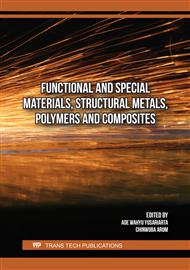[1]
A. A. Selaimia, M. A. Yallese, H. Bensouilah, I. Meddour, R. Khattabi, T. Mabrouki, Modeling and optimization in dry face milling of X2CrNi18-9 austenitic stainless steel using RMS and desirability approach. Measurement, 107 (2017) 53-67.
DOI: 10.1016/j.measurement.2017.05.012
Google Scholar
[2]
J. M. Vieira, A. R. Machado, E. O. Ezugwu, Performance of cutting fluids during face milling of steels. Journal of Materials Processing Technology 116 (2001) 244-251.
DOI: 10.1016/s0924-0136(01)01010-x
Google Scholar
[3]
K. Simunovic, G. Simunovic, T. Saric, Single and multiple goal optimization of structural steel face milling process considering different methods of cooling/lubricating. Journal of cleaner production 94 (2015) 321-329.
DOI: 10.1016/j.jclepro.2015.02.015
Google Scholar
[4]
D. Y. Pimenov, A. T. Abbas, M. K. Gupta, I. N. Erdakov, M. S. Soliman, M. M. El Rayes, Investigations of surface quality and energy consumption associated with costs and material removal rate during face milling of AISI 1045 steel. The International Journal of Advanced Manufacturing Technology 107 (2020) 3511-3525.
DOI: 10.1007/s00170-020-05236-7
Google Scholar
[5]
A. T. Abbas, A. E. Ragab, E. A. Al Bahkali, E. A. El Danaf, Optimizing cutting conditions for minimum surface roughness in face milling of high strength steel using carbide inserts. Advances in Materials Science and Engineering 2016 (2016) 7372132.
DOI: 10.1155/2016/7372132
Google Scholar
[6]
V. K. Sharma, T. Singh, M. Rana, A. K. Singh, K. Chattopadhyay, Experimental investigation of tool wear in face milling of EN-31 steel under different machining environments. Materials Today: Proceedings 50 (2022) 2135-2142.
DOI: 10.1016/j.matpr.2021.09.438
Google Scholar
[7]
R. Binali, H. Demirpolat, M. Kuntoğlu, H. Sağlam, Machinability investigations based on tool wear, surface roughness, cutting temperature, chip morphology and material removal rate during dry and MQL-assisted milling of Nimax mold steel. Lubricants 11 (2023) 101.
DOI: 10.3390/lubricants11030101
Google Scholar
[8]
F. M. Mohamed, F.B. Brahim, B. T. Toufik, Y. Mohamed Athmane, Optimization and mathematical modelling of surface roughness criteria and material removal rate when milling C45 steel using RSM and desirability approach. Journal of Mechanical Engineering (JMechE), 20 (2023) 173-197.
DOI: 10.24191/jmeche.v20i3.23907
Google Scholar
[9]
S. B. Kedare, D. R. Borse, P. T. Shahane, Effect of minimum quantity lubrication (MQL) on surface roughness of mild steel of 15HRC on universal milling machine. Procedia Materials Science 6 (2014) 150-153.
DOI: 10.1016/j.mspro.2014.07.018
Google Scholar


